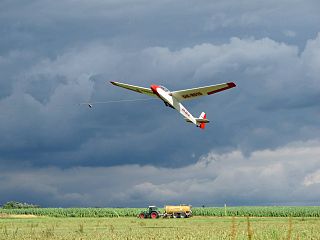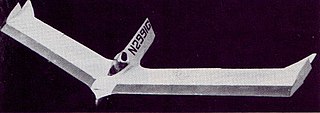
The Lo-100 is an aerobatic glider of classic wood and fabric construction well suited to amateur building methods. The designation Lo was bestowed by the designer Alfred Vogt in memory of his brother Lothar Vogt, with whom he had developed the predecessor model Lo-105 Zwergreiher. The first flight of the prototype took place in 1952 at the Klippeneck. An example is on display at the Gliding Heritage Centre.

The Aer-Pegaso M-100 was a single-seat glider designed and built in Italy from 1957.

The Antonov A-13 was a Soviet aerobatic sailplane flown in the 1950s and 1960s. It was a small, single-seat, all-metal aircraft developed from the A-11 which could optionally be fitted with that aircraft's longer-span wings. It was a mid-wing monoplane with a tadpole-like fuselage and a V-tail.
The Schneider ES-59 Arrow is a sailplane designed and manufactured in Adelaide, South Australia in the early 1960s. The Arrow was manufactured with a one-piece wing of 13.23 metres span. It was the first Australian-built sailplane to compete in the World Gliding Championships, 1963 in Argentina. The Arrow has wood/fabric wings and tail and a wood fuselage. It has a fixed main wheel and a nose skid.

The Schweizer SGS 2-32 is an American two-seat, mid-wing, two or three-place glider built by Schweizer Aircraft of Elmira, New York.

The Slingsby T.6/T.23 Kirby Kite was a single-seat sport glider produced from 1935, by Fred Slingsby in Kirbymoorside, Yorkshire.

The Scheibe Bergfalke is a German glider designed by Egon Scheibe as a post-World War II development of the Akaflieg München Mü13 produced before and during the war.

The Slingsby Type 45 Swallow was designed as a club sailplane of reasonable performance and price. One of the most successful of Slingsby's gliders in sales terms, over 100 had been built when production was ended by a 1968 factory fire.

The DFS Weihe is a German single-seat, high-wing, 18 metre wingspan, high-performance glider that was designed by Hans Jacobs in 1937-38.
The Ross R-6 is a tandem two-seat, high-wing glider that was designed by Harland Ross and first flown in 1956.

The Schreder Airmate HP-8 is an American, high-wing single seat glider that was designed by Richard Schreder after the loss of the HP-7 in 1957.

The Johnson RHJ-6 Adastra was an American mid-wing, two-seat glider that was designed and constructed by Dick Johnson and first flown on 3 April 1960.

The Hütter Hü 17, is a German high-wing, strut-braced, single-seat, utility training glider that was designed by brothers Ulrich Hütter and Wolfgang Hütter in the 1930s.
The Vogt Lo-150 is a West German high-wing, single seat glider that was designed by Alfred Vogt and produced by the Wolf Hirth Company.

The Lehtovaara PIK-16 Vasama is a Finnish mid-wing, single-seat, FAI Standard Class glider that was designed by Tuomo Tervo, Jorma Jalkanen and Kurt Hedstrom, who were students at the Polyteknikkojen Ilmailukerho (PIK) and produced by Lehtovaara.

The N.V. Vliegtuigbouw 013 Sagitta is a Dutch mid-wing, single-seat Standard Class glider designed by Piet Alsema and produced by N.V. Vliegtuigbouw.

The Schleicher Ka-4 Rhönlerche II, sometimes called the KA-4 or even K 4, is a West German high-wing, strut-braced, two-seat glider that was designed by Rudolf Kaiser and produced by Alexander Schleicher GmbH & Co.

The Schleicher K7 Rhönadler is a West German high-wing, two-seat, glider that was designed by Rudolf Kaiser and produced by Alexander Schleicher GmbH & Co.

The Brochocki BKB-1 was a Canadian mid-wing, single-seat, experimental tailless glider that was designed and constructed by Stefan Brochocki with assistance from Witold Kasper and A. Bodek. The designation indicated the contributions of all three men. The aircraft was intended to study flight above the stall angle.
The IS-2 was an intermediate training glider designed by Iosif Şilimon and built in Romania in the 1950s at the URMV-3 factory at Brașov.




















